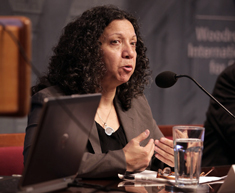-
Susana Adamo: Migration Is Changing the Geography of Climate Change Vulnerability
June 13, 2014 By Moses Jackson
While it may seem obvious, it bears repeating that certain parts of the world are more susceptible than others to the adverse impacts of climate change. And since humans are distributed unevenly across the earth’s surface, certain people are more susceptible than others as well.
While it may seem obvious, perhaps it bears repeating that certain parts of the world are more susceptible than others to the adverse impacts of climate change. And since humans are distributed unevenly across the earth’s surface, certain people are more susceptible than others as well.
“Migration is the quickest response to any change in underlying conditions”But people can move, and in many ways it’s easier to do so than ever before. This raises important questions for climate response strategies. “The geography of vulnerability is changing because of the effect of high migration,” says Colombia University demographer Susana Adamo in this week’s podcast.
In places like West Africa and Mexico, “dry ecosystems are usually losing population, and the coastal ecosystems – where most of the urban areas are – are increasingly having more and more in-migration,” says Adamo.
Migration is one of three major demographic processes, along with fertility and mortality, that influence population distribution. But changes in fertility and mortality may take generations to play out, while “migration is the quickest response to any change in underlying conditions” and may have an impact in only 10 or 15 years, says Adamo.
Around 2008, according to the United Nations, the world crossed a divide: for the first time, more than half of the world’s population was living in cities. This urbanization trend has been fueled primarily by rural-to-urban migration, but as areas become more urban, migration between and within cities is starting to play a greater role, especially since many coastal cities are more vulnerable to climate change impacts like sea-level rise and extreme weather events.
Migration data is seen as the weak link in the demographic recordA growing number of researchers are investigating the factors that determine who migrates, why, where they go, and how this process affects origin and destination areas. These are difficult questions to answer. “It has to do with how habitable the area is in terms of resources, in terms of climate, and in terms of topology or topography,” says Adamo. History can play a major role in why certain areas are more or less desirable than others too.
Despite a recent proliferation of studies investigating migration as a response to climate change, more data is needed to advance our understanding, says Adamo. Migration data is seen as “the weak link of the demographic record,” she says. And while there have been great advances in this area, “there is still more that has to be done.”
Susana Adamo spoke at the Wilson Center on May 14. Download her slides to follow along.
Friday podcasts are also available for download on iTunes.
 A Publication of the Stimson Center.
A Publication of the Stimson Center.




